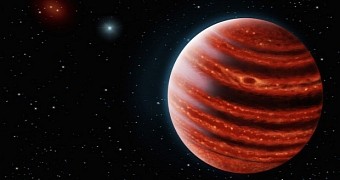A new study in the journal Science Express announces the discovery of a baby Jupiter in a triple-star system merely 100 light-years away from our planet.
The previously undocumented orb was discovered by a team of astronomers at the University of California, Berkeley, who detected it with the help of the Gemini Planet Imager.
The high contrast imaging instrument, mounted atop the Gemini South telescope in Chile, only recently went into the business of searching for planets. In fact, researchers say this young Jupiter it spotted close to our cosmic neighborhood is its first find.
So, what's so special about this planet?
Our Solar System is nearly 5 billion years old. The Jupiter-like orb identified with the help of the Gemini Planet Imager, however, has only been around for about 20 million years, which means it is still in its infancy.
The planet, named 51 Eridani b, is said to be about 1 million times fainter than its parent star and quite cold. Thus, scientists estimate it has a surface temperature of about 430 degrees Celsius (800 Fahrenheit). Even so, its methane signature is the strongest so far documented on an alien planet.
“Judging by its low luminosity, low temperature and strong methane signature, this is the most Jupiter-like exoplanet ever directly imaged,” astronomer James Graham said in a statement.
Although much younger, 51 Eridani b is twice the mass of Jupiter. As for its place in the cosmos, the planet appears to be orbiting its parent star just a tad further than our Saturn orbits the Sun.
“The planet is estimated to be about twice the mass of Jupiter, and orbits at a distance of 13 astronomical units, or slightly farther from its star than Saturn is from the sun. One astronomical unit, or AU, is equal to the Earth-sun distance, or 150 million kilometers (93 million miles).”
The planet probably formed like Jupiter too
Judging by its features, scientists suspect the newly discovered 51 Eridani b came into being much like our Jupiter. More precisely, they say it probably formed from a large rocky core that, over the years, pulled in gases from its surroundings and fashioned itself an atmosphere.
If this is indeed what happened, this would mean the orb is even more like Jupiter than just its looks suggest. In turn, this would mean the planetary system it is part of is not all that different to our own.

 14 DAY TRIAL //
14 DAY TRIAL //